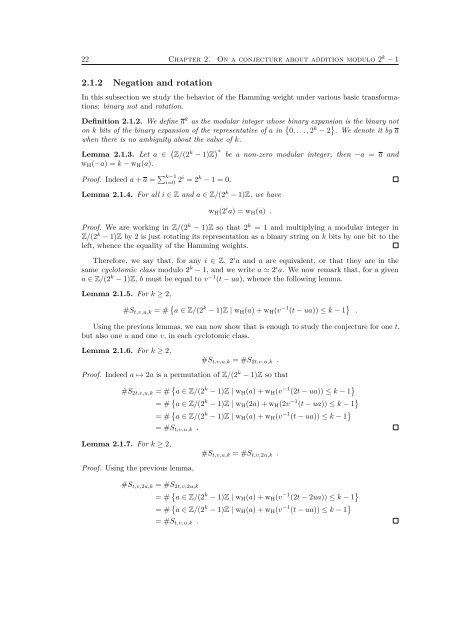here - Sites personnels de TELECOM ParisTech - Télécom ParisTech
here - Sites personnels de TELECOM ParisTech - Télécom ParisTech
here - Sites personnels de TELECOM ParisTech - Télécom ParisTech
Create successful ePaper yourself
Turn your PDF publications into a flip-book with our unique Google optimized e-Paper software.
22 Chapter 2. On a conjecture about addition modulo 2 k − 12.1.2 Negation and rotationIn this subsection we study the behavior of the Hamming weight un<strong>de</strong>r various basic transformations:binary not and rotation.Definition 2.1.2. We <strong>de</strong>fine a k as the modular integer whose binary expansion is the binary noton k bits of the binary expansion of the representative of a in { 0, . . . , 2 k − 2 } . We <strong>de</strong>note it by awhen t<strong>here</strong> is no ambiguity about the value of k.Lemma 2.1.3. Let a ∈ ( Z/(2 k − 1)Z ) ∗be a non-zero modular integer, then −a = a andw H (−a) = k − w H (a).Proof. In<strong>de</strong>ed a + a = ∑ k−1i=0 2i = 2 k − 1 = 0.Lemma 2.1.4. For all i ∈ Z and a ∈ Z/(2 k − 1)Z, we havew H (2 i a) = w H (a) .Proof. We are working in Z/(2 k − 1)Z so that 2 k = 1 and multiplying a modular integer inZ/(2 k − 1)Z by 2 is just rotating its representation as a binary string on k bits by one bit to theleft, whence the equality of the Hamming weights.T<strong>here</strong>fore, we say that, for any i ∈ Z, 2 i a and a are equivalent, or that they are in thesame cyclotomic class modulo 2 k − 1, and we write a ≃ 2 i a. We now remark that, for a givena ∈ Z/(2 k − 1)Z, b must be equal to v −1 (t − ua), whence the following lemma.Lemma 2.1.5. For k ≥ 2,#S t,v,u,k = # { a ∈ Z/(2 k − 1)Z | w H (a) + w H (v −1 (t − ua)) ≤ k − 1 } .Using the previous lemmas, we can now show that is enough to study the conjecture for one t,but also one u and one v, in each cyclotomic class.Lemma 2.1.6. For k ≥ 2,#S t,v,u,k = #S 2t,v,u,k .Proof. In<strong>de</strong>ed a ↦→ 2a is a permutation of Z/(2 k − 1)Z so that#S 2t,v,u,k = # { a ∈ Z/(2 k − 1)Z | w H (a) + w H (v −1 (2t − ua)) ≤ k − 1 }= # { a ∈ Z/(2 k − 1)Z | w H (2a) + w H (2v −1 (t − ua)) ≤ k − 1 }= # { a ∈ Z/(2 k − 1)Z | w H (a) + w H (v −1 (t − ua)) ≤ k − 1 }= #S t,v,u,k .Lemma 2.1.7. For k ≥ 2,#S t,v,u,k = #S t,v,2u,k .Proof. Using the previous lemma,#S t,v,2u,k = #S 2t,v,2u,k= # { a ∈ Z/(2 k − 1)Z | w H (a) + w H (v −1 (2t − 2ua)) ≤ k − 1 }= # { a ∈ Z/(2 k − 1)Z | w H (a) + w H (v −1 (t − ua)) ≤ k − 1 }= #S t,v,u,k .
















